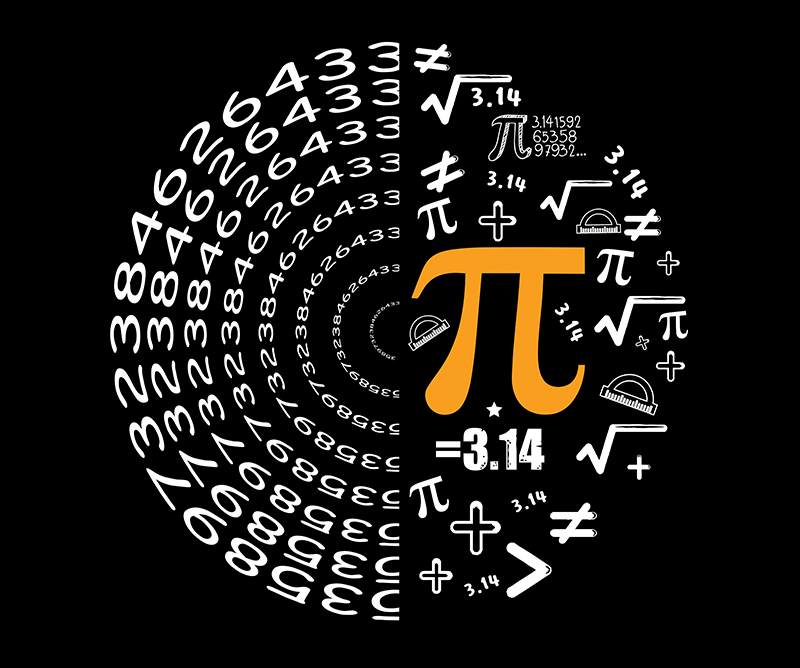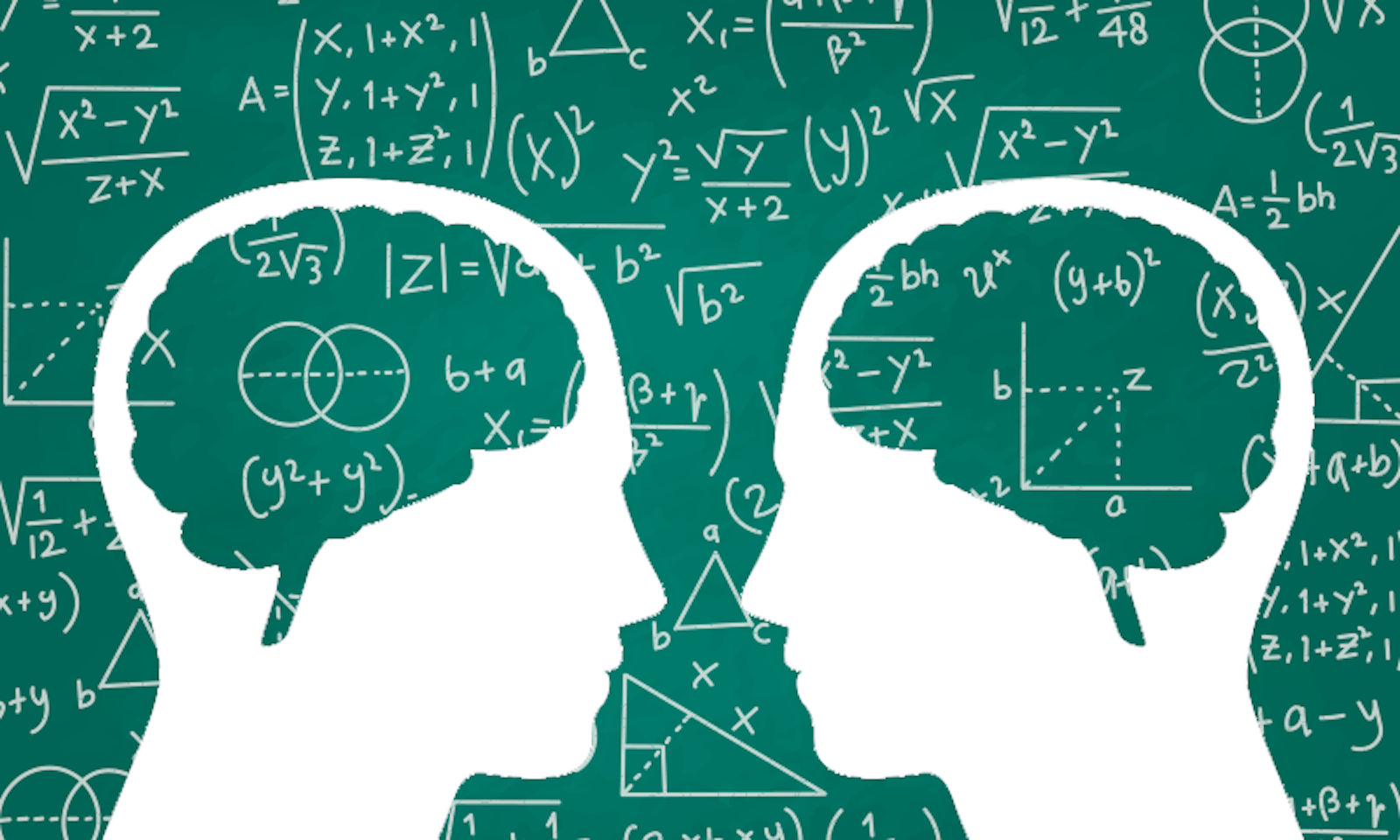Ken Ono gets excited when he talks about a particular formula for pi, the famous and enigmatic ratio of a circle’s circumference to its diameter. He shows me a clip from a National Geographic show where Neil Degrasse Tyson asked him how he would convey the beauty of math to the average person on the street.
In reply, Ono showed Tyson, and later me, a so-called continued fraction for pi, which is a little bit like a mathematical fun house hallway of mirrors. Instead of a single number in the numerator and one in the denominator, the denominator of the fraction also contains a fraction, and the denominator of that fraction has a fraction in it, too, and so on and so forth, ad infinitum. Written out, the formula looks like a staircase that narrows as you descend its rungs in pursuit of the elusive pi. The calculation—credited independently to British mathematician Leonard Jay Rogers and self-taught Indian mathematician Srinivasa Ramanujan—doesn’t involve anything more complicated than adding, dividing, and squaring numbers. “How could you not say that’s amazing?” Ono, chair of the mathematics department at the University of Virginia, asks me over Zoom.
We could redesign math education so that it supports rather than undermines learning.
As a fellow pi enthusiast—I am well known among friends for hosting Pi Day pie parties—I had to agree with him that it’s a dazzling formula. But not everyone sees beauty in fractions, or in math generally. In fact, here in the United States, math often inspires more dread than awe. In the 1950s, some educators began to observe a phenomenon they called mathemaphobia in students,1 though this was just one of a long list of academic phobias they saw in students. Today, nearly 1 in 5 U.S. adults suffers from high levels of math anxiety, according to some estimates,2 and a 2016 study found that 11 percent of university students experienced “high enough levels of mathematics anxiety to be in need of counseling.”3
Math anxiety seems generally correlated with worse math performance worldwide, according to one 2020 study from Stanford and the University of Chicago.4 While many questions remain about the underlying reasons, high school math scores in the U.S. tend to rank significantly lower than those in many other countries. In 2018, for example, American students ranked 30th in the world in their math scores on the PISA exam, an international assessment given every three years.
Some scholars argue that American culture’s saturation with negative stereotypes around math in combination with current approaches to teaching the subject are perpetuating anxiety, making some kids think they are bad at math, and preventing them from excelling. Research shows that humans are born with an inherent sense of numbers, known as numerosity.5 The concept of numerosity is one of the only high-level cognitive functions that is mapped to a specific region of the brain. In other words, we are primed to do basic math, but culture gets in the way. Recent neuroscientific, behavioral, and cognitive research could help us redesign math education so that it supports rather than undermines learning—and even inspires a love for the mysterious elegance of math along the way.
The subject of “math” is far-reaching and wide-ranging—it covers everything from counting to prime numbers to algebraic topology. But at the most rudimentary level, science suggests that we are all born with a sense of quantity.6 Human infants are able to understand this concept as early as 6 months old, long before they have had substantial exposure to human culture or language. And this preverbal sense for numbers is thought to be a building block for later math ability in both childhood and adulthood.7 In one study, researchers found that 3-year-old children who had higher intuitive number sense as infants scored significantly better on math achievement tests, even when the researchers controlled for general intelligence. And a 2013 study by Joonkoo Park and psychologist Elizabeth Brannon, both then at Duke University, found that students could improve their math proficiency through training that engaged their ability to estimate quantities.8
This ability to estimate and understand quantity may have evolved as a basic survival skill. It could have helped our ancestors and members of other species quickly assess whether they were outnumbered by predators, for example, or to forage in places with more available food relative to others. Andreas Nieder of the University of Tübingen in Germany, who has studied numerical perception in a diversity of species, believes that a cognitive system for perceiving numbers evolved independently, and in parallel, in species such as monkeys, birds, and insects, that lie far from one another in the evolutionary tree. Pigeons can be trained to peck a certain number of times on a board.9 Dolphins seem to be able to understand the numerical concept of “less”10 and honeybees, according to one study, can grasp the concept of “zero.”11

There seems to be consensus among scientists, however, that only humans mentally represent numbers precisely and with symbols, and that we need some kind of education to do so. This is potentially because many higher math skills, including arithmetic, depend on the use of language—a symbols-based system—where quantity-based judgments are pre-verbal.5 Indeed, arithmetic is difficult to do if one does not have the language for it. One 2004 study, for example, looked at speakers of an Amazonian language called Mundurukú, which does not have words for numbers larger than 5, and found that speakers did not do well “in exact arithmetic with numbers larger than 4 or 5.”12 A 2013 study in Trends in Neuroscience and Education compared the relative mathematical abilities of schooled and unschooled Western adults, and found significant differences in their abilities to approximate large numbers.13
If we have the innate ability to understand math and acknowledge its importance in making sense of the world, why are so many—in Western culture, mainly—averse to it? Scholars who study math and math education have a hard time answering this question.
Perhaps it is related to the way we in the U.S. tend to conceptualize math ability. People in the West often say, “I’m bad at math,” as though it were a personality trait or even a badge of honor. Compared to other school subjects, “I think people have more of a fixed mindset about it,” as though they have “a knob turned to a certain setting,” says Jordan Ellenberg, professor of mathematics at the University of Wisconsin-Madison and author of Shape: The Hidden Geometry of Information, Biology, Strategy, Democracy, and Everything Else. “That’s a pretty bad misconception,” he added.
Of course, some kids do have clinical learning disabilities that are not caused by anxiety, cultural myths, or poor teaching. Developmental dyscalculia, a clinical term for someone who has a math-related learning disability, affects about 3 to 7 percent of the population. This is the lesser-known analog of dyslexia, a learning disability related to reading, and the two conditions often occur together.
People in the West often say, “I’m bad at math,” as though it were a personality trait.
But believing you are bad at math can become a self-fulfilling prophecy. Evidence suggests that cultural assumptions that women are less skilled at math than men may account for much of the gender gap in math performance. Racial stereotypes can also undermine performance. Ebony McGee, professor of diversity and STEM education at Vanderbilt University, has spent more than a decade looking at issues of systemic racism in STEM fields. In her book Black, Brown and Bruised: How Racialized STEM Education Stifles Innovation, she notes that Black, Indigenous, and Latinx students regularly report experiences of “isolation, feeling or being positioned as an impostor,” as well as other racialized biases that distract them from their studies and sap their energy.
Math anxiety may be transmitted from teachers and parents to kids, too. “Evidence from the United States suggests that children who interact with high-math-anxiety adults show impaired math performance relative to their peers,” the authors of a 2017 study wrote.4 Taking the approach that kids should be rewarded for struggling and spending time learning math concepts, not just for giving correct answers, Jo Boaler and colleagues at Stanford University are developing an online resource for parents called Struggly. “The neuroscience very clearly shows everybody’s on a growth journey,” Boaler said. “There’s no kind of cut off where somebody becomes gifted.”
Even calling a child “gifted” or “smart”—or telling them that they have a “math brain,” as Boaler puts it—can have unintended consequences by setting an expectation that can later be hard to meet. I relate to this. I loved learning advanced math in “gifted” summer programs in high school, but later struggled in multivariable calculus during my first college semester and became convinced the gift had expired. No one suggested that my frustrating long nights of study just to come off with a B were supposed to be part of a journey. Instead, like so many others, I just didn’t take any more math courses.
One key question for math educators has long been how to teach broad concepts and foster deep understanding while balancing the parts of the classroom that kids often dread most: memorization and repetition.
Just over a decade ago, most U.S. states adopted the Common Core State Standards in Mathematics, which set out ambitious targets for student learning from kindergarten through 12th grade. The standards apply not just to the content of math instruction, but to the ways it is taught. One of the aims was to transition teaching methods away from drills and memorization toward a greater emphasis on understanding mathematical concepts and how they relate to one another. Research on whether the new standards have led to improvements in math achievement is “sparse and full of caveats,” write the authors of a 2021 paper in AERA Open journal. They found in their study of Chicago schools that when teachers have been specifically trained to implement the standards, kids who had been under-performing had significantly better grades, pass rates and test scores.14
Boaler and colleagues advocate for reforming California’s Mathematics Framework, a set of teaching standards that sits alongside the Common Core, to group math concepts together into “big ideas” that have relevance to the lived world. For example, third graders could learn concepts like fractions and polygons—which are typically taught separately—together in the context of floor tile shapes. By combining them, “teachers can focus on fewer things, but richer with more connections,” she said. And Boaler is down on timed memorization drills, which she says contribute to math anxiety. The facts of math—the results of 7 times 8 and the like—are still important, Boaler says, but lessons that emphasize their meaning and situational relevance best help students learn them.
There are correlations between math and music in terms of common brain areas.
A seemingly opposing perspective comes from Barbara Oakley, author of A Mind For Numbers: How to Excel at Math and Science, who argues that, ultimately, learning math is more like learning a language or learning music than it is like some other forms of learning. In a personal essay for Nautilus about how she turned on to math and became a mathematician late in life, she wrote that repetition and memorization are essential, and that a focus on understanding concepts over rote practice can undermine math learning. While this might seem like a debate, it doesn’t have to be—no curriculum is going to be purely concept driven or purely memorization-driven. Everyone needs to understand the concepts, but also practice using them. In fact, students who rely on memorization alone to learn math—the U.S. has ranked high in this category in the past—consistently perform worse than those who focus on understanding the relationship between concepts on the PISA math assessment.15
A method that seems to combine both concepts and practice is called “chunking.” It involves turning the material you need to learn into “chunks,” which are “pieces of information that are bound together through meaning,” Oakley writes in her book. The idea is that by breaking down big problems, concepts, or processes, you can focus on tackling the individual components in digestible pieces.
In interviews, Oakley often uses the example of backing up a car. If you have never driven before, you need to think about the entire sequence of actions to make this happen: Look in the mirrors, check blind spots, put the car in reverse, turn the steering wheel, etc. But once you back up your car often enough, it becomes second nature—you don’t even think about the individual steps. The same can be said for any math principle you’re trying to learn, Oakley writes. She outlines a three-step process for chunking: focusing attention on the chunk, understanding the underlying idea behind that piece of information, and looking at its context. As you memorize and thoroughly practice each chunk, you can meld them into bigger chunks that are connected conceptually.
Boaler also argues for more multisensory approaches to learning, pointing to research published by cognitive neuroscientist Vinod Menon in 2015.16 Menon and his colleagues at Stanford found that when a child works on a math problem, five different brain areas are active, and two of them are related to visual pathways. If math lessons involved more visualizations and other multisensory components, they would tap into these math-learning networks, she argues.
“When they build or model with maths or move with maths, all of these help develop these different parts of the brain,” she said. A 2016 paper that Boaler’s group published in the Journal of Applied and Computational Mathematics makes the point that even higher mathematics is highly visual.17
In Ireland, Flávia Santos’s group has been exploring how the interconnectedness of math and music might be used to help kids with dyscalculia. Neuroscience research supports the idea that there are correlations between math and music in terms of common brain areas activated during relevant activities.
Both math and music are inherently systems with symbols, Santos points out. It’s impossible to prove that proficiency in one causes excellence in the other, but fractions, ratios, and pattern-recognition are important to both. So, Santos figured, musical training may have benefits for math learning, too.18 Studies show that it enhances spatial-temporal reasoning, which supports learning mathematical concepts. So far, the results are promising, although only small groups have been observed. For example, in a 2020 study in the journal Frontiers in Psychology, her group reports that a training involving singing, percussion, and corporal movement, had positive associations with scores on math comprehension tests in a small sample of kids in Brazil.19
Ultimately, individual kids have specific needs, and parents can work with teachers on figuring out tailored approaches. But, generally parents can create a positive attitude toward math by refraining from sharing their own math anxieties and encouraging creative problem solving. “Never share with your child, ‘I was bad at math,’ ‘I hate math,’ any of those statements we know can negatively affect students,” Boaler says. “But also just try and engage in math, to help them see it as an interesting puzzle.”
Ono’s father Takashi, a professor of mathematics at Johns Hopkins University, urged him to pursue math from a young age. “For the longest time, math meant calculations, or memorization,” Ono says. But he developed a true passion for it in 10th grade when a “magical letter” arrived from India to the family’s Lutherville, Maryland, home. Typed on rice paper, the letter came from the widow of mathematician Srinivasa Ramanujan, who had died at age 32. She thanked Ono’s father for helping to fund the creation of a bust of Ramanujan in his memory. Takashi, teary-eyed, told his son about the obstacles Ramanujan overcame—racial prejudice, poverty, dropping out of college twice—to become one of the most influential mathematicians of the 20th century.
Ono saw parallels between Ramanujan’s story and his own father’s journey to mathematics. And Ramanujan, who came up with that continued fraction formula for pi that Ono showed me, stuck with him. Ono went on to pursue an academic career and has become famous in the math world for solving mysteries and questions that arose from Ramanujan’s work.
“For me, Ramanujan symbolizes true creativity, flights of imagination that you might think would be like, poetry coming out of the mind of a great poet,” Ono told me. “You don’t know where it comes from. And then you have to ponder them deeply and appreciate the words or the formulas that are on a page. That, I like.” ![]()
Lead images: Illustrator096 / Shutterstock and Peter Hermes Furian / Shutterstock
References
1. Furness, E.L. Are we victims of linguaphobia? The Modern Language Journal 42, 20-22 (1958).
2. Ashcraft, M.H. & Moore, A.M. Mathematics anxiety and the affective drop in performance. Journal of Pscyhoeducational Assessment 27, 197-205 (2009).
3. Richardson, F.C. & Suinn, R.M. The mathematics anxiety rating scale: Psychometric data. Journal of Counseling Psychology 19, 5510554 (1972).
4. Foley, A.E., et al. The math anxiety-performance link” A global phenomenon. Current Directions in Psychological Science 26, 52-58 (2017).
5. Reas, E. Our brains have a map for numbers. Scientific American (2014).
6. Xu, F., Spelke, E.S. & Goddard, S. Number sense in human infants. Developmental Science 8, 88-101 (2005).
7. Starr, A., Libertus, M.E., & Brannon, E.M. Number sense in infancy predicts mathematical abilities in childhood. Proceedings of the National Academy of Sciences 110, 18116-18120 (2013).
8. Park, J. & Brannon, E.M. Training the approximate number system improves math proficiency. Psychological Science 24, 2013-2019 (2013).
9. Morell, V. No joke: Pigeons ace a simple math test. Science.org (2011).
10. Jaakkola, K., Fellner, W., Erb, L., Rodriguez, M., & Guarino, E. Understanding of the concept of numerically “less” by bottlenose dolphins (Tursiops truncatus). Journal of Comparative Psychology 119, 296-303 (2005).
11. Howard, S.R., Avargués-Weber, A., Garcia, J.E., Greentree, A.D., & Dyer, A.G. Numerical ordering of zero in honey bees. Science 360, 1124-1126 (2018).
12. Pica, P., Lemur, C., Izard, V., & Dehaene, S. Exact and approximate arithmetic in an Amazonian indigene group. Science 306, 499-503 (2004).
13. Nys, J., et al. Does math education modify the approximate number system? A comparison of schooled and unschooled adults. Trends in Neuroscience and Education 2, 13-22 (2013).
14. Allensworth, E., Cashdollar, S., & Gwynne, J. Improvements in math instruction and student achievement through professional learning around the common core state standards in Chicago. AERA Open (2021). Retrieved from DOI:10.1177/2332858420986872
15. Boaler, J. & Zoido, P. Math education in the US doesn’t add up. Scientific American Mind (2016).
16. Menon, V. Salience network. In Toga, A.W. (Ed.) Brain Mapping: An Encyclopedic Reference, Volume 2 Academic Press, Cambridge, MA (2015).
17. Boaler, J., Chen, L., Williams, C., & Cordero, M. Seeing as understanding: The importance of visual mathematics for our brain and learning. Journal of Applied & Computational Mathematics 5 (2016).
18. Ribeiro, S. & Santos, F.H. Enhancement of numeric cognition in children with low achievement in mathematic after a non-instrumental musical training. Research in Developmental Disabilities 62, 26-39 (2017).
19. Ribeiro, S. & Santos, F.H. Persistent effects of musical training on mathematical skills of children with developmental disabilities. Frontiers in Psychology 10 (2020).




























